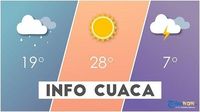Indonesians across the archipelago are bracing for a week of unpredictable skies, as the nation’s weather agency, BMKG (Badan Meteorologi, Klimatologi, dan Geofisika), issues a series of warnings and advisories for September 22, 2025. From Sumatra to Sulawesi, and Java to Papua, the forecast calls for everything from bright, sunny mornings to thunderstorms, strong winds, and the ever-present risk of flooding and landslides. The shifting weather is a telltale sign: Indonesia is stepping into the transitional season, known locally as pancaroba, when dry days give way to the first rains of the wet season.
According to KOMPAS.TV and BMKG forecaster Ina Indah Hapsari, the widespread pattern of cloudy skies and light rain emerging at the start of the week signals that the archipelago is entering this crucial period. “Many regions are now starting to experience erratic weather, with light rainfall in several cities and thunderstorms in certain areas,” Hapsari explained in an online briefing on Monday. She emphasized that such conditions—hot mornings followed by rain from afternoon through evening—are a hallmark of pancaroba. Residents are urged to pay close attention to local forecasts, as the rapid shifts can catch even seasoned locals off guard.
In Kota Bogor, West Java, the day began with a gentle, bright sunrise and temperatures hovering around a comfortable 28–29°C, as reported by POJOKSATU. The early hours, from 6:00 to 10:00 AM, offered a perfect window for outdoor activities—be it jogging, commuting, or sending children off to school. By midday, however, the mercury crept up to between 31 and 33°C, and the sky turned partly cloudy. “Residents who need to be outside should bring a hat, umbrella, or sunscreen to avoid direct sun exposure,” local advisories recommended. As the afternoon wore on, the wind picked up and clouds thickened—a prelude to what was coming next.
By late afternoon and early evening, the forecast predicted rain and thunderstorms, with temperatures dropping to 24–26°C. Such storms aren’t unusual in Bogor during the transition season, but the risk they pose is real. “People who are still outside are urged to be cautious of lightning and avoid open spaces and tall trees when the rain starts,” warned the POJOKSATU report. After 9:00 PM, the rain and thunder were expected to subside, leaving behind cooler, partly cloudy conditions. The night’s chill, with temperatures settling at 23–24°C, might seem refreshing, but slippery roads and possible flooding in low-lying areas remained a concern for those returning home late.
Elsewhere in Indonesia, the BMKG’s early warning system was in full swing. According to CNBC Indonesia and KompasTV, the agency issued alerts for September 22 and 23, flagging a range of weather hazards. In Aceh, Sumatera Barat, and Papua, moderate to heavy rainfall was expected, placing these regions on alert. Sumatera Utara faced an even starker warning, with the potential for very heavy rain prompting a “siaga” (high alert) status. The BMKG also cautioned residents in Banten, Jawa Barat, Jawa Timur, and Nusa Tenggara Barat about the risk of strong winds—conditions that can topple trees, damage property, and disrupt transportation.
Riau, Sulawesi Utara, and Papua were once again on the watchlist, while areas like Maluku, Bengkulu, and Papua Pegunungan were bracing for heavy downpours. These advisories are not issued lightly. The BMKG’s goal, as stated in their public warnings, is to “increase public awareness of potential hydrometeorological disasters such as floods, landslides, and strong winds, especially in vulnerable areas.” In a country as geographically diverse and disaster-prone as Indonesia, such vigilance can be a literal lifesaver.
On the islands of Nias, the local BMKG office in Gunungsitoli provided a more nuanced picture. Forecaster Inlim told KBRN that Monday would bring cloudy skies with the potential for light rain in the morning and afternoon, especially in West Nias and Nias regencies. Temperatures were set to range from 23 to 31°C, with humidity reaching up to 99%. Winds from the southeast would sweep across the islands at 10–25 km/h, and sea conditions were expected to be manageable, with waves between 0.5 and 2.5 meters. For fishermen and coastal communities, these details matter—a sudden squall or a rogue wave can turn a routine day at sea into a dangerous ordeal.
Meanwhile, in South Sulawesi, the cities of Makassar, Maros, and Gowa were forecasted to enjoy partly cloudy weather through most of the day, as reported by BMKG Wilayah IV Makassar. Only the highland districts of Luwu Timur, Enrekang, and Toraja Utara were likely to see light rain in the afternoon and evening. “No early weather warnings were issued,” the report noted, offering a rare moment of reassurance in an otherwise unsettled week. Temperatures in the region were expected to swing between 18 and 35°C, with humidity as low as 55% and as high as 98%. Winds from the northeast could reach up to 40 km/h, but nothing severe was anticipated.
Java, Indonesia’s most populous island, was not spared the uncertainty. According to KOMPAS.TV and BMKG’s own forecasts, Jakarta and Yogyakarta were in for light rain, while Semarang would see cloudy skies. Bandung and Serang faced thick clouds, and Surabaya was set for partly cloudy weather. Such patchwork conditions are typical for the transition season, when the interplay between residual dry air and incoming moisture creates microclimates that can shift in a matter of hours. BMKG’s advice was clear: “The public is advised to remain vigilant regarding rapid weather changes, especially in flood and landslide-prone areas.”
Throughout all these updates, one message rang loud and clear: Indonesia’s weather can change on a dime, especially during pancaroba. Light rain can escalate into a downpour; a sunny morning can give way to a thunderstorm by dusk. The risks—flooding, fallen trees, traffic disruptions—are real, and so is the need for caution. BMKG’s warnings, whether about thunderstorms in Bogor, strong winds in West Java, or heavy rain in Sumatera Utara, are not just bureaucratic routine. They are grounded in hard data and years of experience, and they serve as a vital line of defense for communities large and small.
As the week unfolds, Indonesians will be watching the skies, umbrellas and raincoats at the ready, hoping for the best but preparing for whatever the weather may bring. In a nation where the next storm is never far away, a little preparation—and a lot of attention to the forecast—can make all the difference.





